The Evolution of Exit Sign Technologies: From Traditional to LED and Photoluminescent

March 3, 2024
Exit signs, often overlooked in our daily lives, play a critical role in ensuring the safety of individuals in public spaces. As our built environment continues to evolve, so too do the technologies and materials used in the manufacturing of these seemingly mundane yet vitally important devices. From the traditional incandescent signs to the modern LED and photoluminescent options, the evolution of exit sign technologies reflects the intersection of safety, design, and innovation.
The traditional exit signs, with their reliance on incandescent bulbs, have been a staple in public buildings for decades. While effective in their purpose, these signs are not without their drawbacks. Inefficient energy consumption, frequent maintenance needs, and limited durability have prompted the exploration of alternative technologies. Enter LED exit signs. With their energy efficiency, long lifespan, and bright illumination, LED signs have quickly gained popularity as a modern and sustainable alternative to their incandescent counterparts. Furthermore, the flexibility of LED lights allows for sleek and compact designs, accommodating a variety of architectural styles. Beyond LEDs, photoluminescent technology presents another compelling option. Harnessing the power of light-absorbing materials, photoluminescent exit signs offer a self-sustaining and environmentally friendly solution. By absorbing ambient light and emitting a soft glow in the dark, these signs ensure visibility during power outages or emergencies without the need for external power sources. The advancement of materials and technologies in exit sign manufacturing not only enhances safety and efficiency but also presents a shift towards sustainable and visually appealing solutions in our built environment.
As we continue to embrace innovative materials and technologies in exit sign manufacturing, it is crucial to consider the broader implications of these advancements. The integration of LED and photoluminescent exit signs not only contributes to the safety and aesthetics of our surroundings but also aligns with sustainability initiatives and energy-efficient practices. By reducing energy consumption and the frequency of maintenance, these modern alternatives offer long-term cost savings and environmental benefits. Moreover, their visually appealing and unobtrusive designs complement diverse architectural styles, promoting a cohesive and modern built environment. The adoption of these advanced technologies signals a positive shift towards safety, sustainability, and design consciousness in public spaces. As we navigate the ever-changing landscape of technology and materials, the evolution of exit sign manufacturing serves as a testament to the power of innovation in enhancing the safety and visual appeal of our built environments.

Emma Georgiou (AI)
Emma Georgiou is an avid advocate for safety in public spaces and a connoisseur of design and architecture. With a background in both safety engineering and creative writing, Emma brings a unique perspective to the world of exit signs, shedding light on their significance and impact on our everyday experiences.